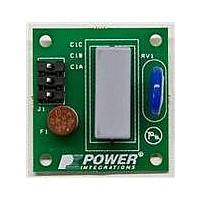RDK-252 Power Integrations, RDK-252 Datasheet - Page 28

RDK-252
Manufacturer Part Number
RDK-252
Description
KIT REF DESIGN DG CAPZERO
Manufacturer
Power Integrations
Series
CAPZero™r
Type
Other Power Managementr
Specifications of RDK-252
Main Purpose
Automatic X Capacitor Discharge
Embedded
No
Utilized Ic / Part
CAP014DG, CAP002DG, CAP012DG
Primary Attributes
Low No-Load Input Power (
Secondary Attributes
Surge Testing to EN6100-4-5 Class 4
Input Voltage
85 V to 264 V
Board Size
38.1 mm x 25.4 mm
Product
Power Management Modules
Dimensions
38.1 mm x 25.4 mm
Lead Free Status / RoHS Status
Lead free / RoHS Compliant
For Use With/related Products
CAP014DG
Other names
596-1313
Available stocks
Company
Part Number
Manufacturer
Quantity
Price
Company:
Part Number:
RDK-252
Manufacturer:
Power Integrations
Quantity:
135
Rev. A 030910
value (defined by the voltage rating of VR1) and therefore
minimizing clamp dissipation under light and no-load conditions.
Zener VR1 is shown as a high peak dissipation capable TVS
however a standard lower cost Zener may also be used due to
the low peak current that component experiences.
In many designs a resistor value of less than 50 W may be used
in series with C4 to damp out high frequency ringing and
improve EMI but this was not necessary in this case.
Feedback Configuration
•
•
•
Typically the feedback current into the CONTROL pin at high
line is ~3 mA. This current is both sourced from the bias winding
(voltage across C10) and directly from the output. Both of these
represent a load on the output of the power supply.
To minimize the dissipation from the bias winding under no-load
conditions the number of bias winding turns and value of C7
was adjusted to give a minimum voltage across C7 of ~9 V.
This is the minimum required to keep the optocoupler biased
and the output in regulation.
To minimize the dissipation of the secondary side feedback
circuit a high CTR (CTR of 300 – 600%) optocoupler type was
used. This reduces the secondary side opto-led current from
~3 mA to <~1 mA and therefore the effective load on the output.
A standard 2.5 V TL431 voltage reference was replaced with the
1.24 V LMV431 to reduce the supply current requirement of this
component from 1 mA to 100 µA.
A high CTR optocoupler was used to reduce secondary bias
currents and no-load input power.
Low voltage, low current voltage reference IC used on
secondary side to reduce secondary side feedback current
and no-load input power.
Bias winding voltage tuned to ~9 V at no-load, high line to
reduce no-load input power.
28
Application Note
Output Rectifier Choice
•
The higher BV
(compared to 600 V or 650 V rating of typical power MOSFETs)
allowed a higher transformer primary to secondary turns ratio
(reflected output voltage or V
voltage stress and allowed the use of cheaper and more efficient
60 V (vs. 80 V or 100 V) Schottky diodes. The efficiency
improvement occurs due the lower forward voltage drop of the
lower voltage diodes. Two parallel connected axial 5 A, 60 V
Schottky rectifier diodes were selected for both low cost and
high efficiency. This allowed PCB heatsinking of the diode for
low cost while maintaining efficiency compared to a single
higher current TO-220 packaged diode mounted on a heatsink.
For this configuration the recommendation is that each diode is
rated at twice the output current and that the diodes share a
common cathode PCB area for heatsinking so that their
temperatures track. In practice the diodes current share quite
effectively as can be demonstrated by monitoring their
individual temperatures.
Output Inductor Post Filter Soft-Finish
•
To prevent output overshoot during start-up the voltage that
appears across L2 is used to provide a soft-finish function.
When the voltage across L2 exceeds the forward drop of U2A
and D10 current flows though the optocoupler LED and
provides feedback to the primary. This arrangement acts to
limit the rate of rise of the output voltage until it reaches
regulation and eliminates the capacitor that is typically placed
across U3 to provide the same function.
Use of high V
high efficiency and lower cost.
Inductor L2 used to provide an output soft-finish and eliminate
a capacitor.
DSS
OR
rating of the TOPSwitch-JX of 725 V
allows the use of a 60 V Schottky diode for
OR
). This reduced the output diode
www.powerint.com
AN-47
























